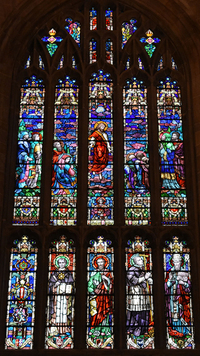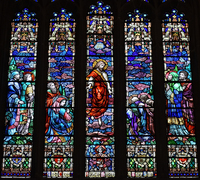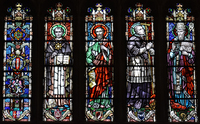Window
Building Name: Cathedral of the Most Blessed SacramentStudio Name: Willet Hauser Architectural Glass
City: Detroit
Window Shape: 6 (gothic arched, more than 2 vertical sections)
Subject/Title of Window: The Ascension of Christ
Brief Description of Subject: The canopy topping this 5 panel window is decorative in nature highlighted by angels with a censer.
The scene below is topped with decorative inscriptions based on Matt. 28:4-5 ----- the Resurrection scene where the two Mary's had come to anoint the body of Jesus and an angel appeared at the tomb "And for fear of him the guards trembled and became like dead men. But the angel said to the women 'Do not be afraid, for I know you seek Jesus.'" This depiction of the Ascension is covered in Acts 1. The "Guide to the Cathedral of the Most Blessed Sacrament" gives an excellent description of this scene (see last paragraph). Just a comment. In Mark's version of the Resurrection, Christ was taken up to heaven and sits on the right hand of God. Above Christ's head, in heaven, is seen the Hebrew letters "YHWH" which is the Old Testament word for "God"; it is phonetically pronounced "Yahweh", the English equivalent of this would be "Jehovah". Below the scene are decorative coats-of-arms as befitting a Norman styled church and an angel holding a tablet with two letters -- I do not know what is the meaning of this.
In the lower portion of this window is found four saints with the artist's creation of their coat-of-arms as well as a decorative panel.
The first panel is decorative in nature with featuring Christian icons and inscribed "Praise Him".
St. Thomas Aquinas (c.1225-1274) became a Dominican friar and was arguably the most important Catholic theologian. His greatest work was the "Summa Totius Theologiae" which, as the title implies, covered all aspects of Christian philosophy. It was written in three parts, although he never competed the third part as he stopped writing in the last year of his life. He wrote the "Office for Corpus Christi" as well as composing hymns for that occasion that are still popular today, parts of which are known as "Tantum Ergo" and "Panis Angelicus". His attributes seen here include dressed as a Dominican friar, a quill pen on a book with the words "Summa Totius Theologiae Tri Partita", on the ground an abbot's miter (this indicates he refused an offer to be an abbot), and on his breast a very shining stone ---- this comes from the legend that a friar named Albert was praying in Church when two people appeared to him, a bishop and a friar. The bishop identified himself as St. Augustine who told him that the friar was St. Thomas Aquinas who is in heaven. On St. Thomas's breast was a stone that shone so bright it illuminated the whole Church.
St. Bartholomew was an Apostle who did much of his preaching in Asia Minor. There are many different stories concerning his martyrdom however being flayed alive is the most accepted. His attributes seen here include holding a flaying knife, a flaying knife in his coat-of-arms and in his right hand is a scroll with a line from the Apostles' Creed --- ASCENDED INTO HEAVEN AND SITTETH ON THE RIGHT HAND OF GOD THE FATHER. The Apostles' Creed is made up of twelve of the basic tenets of the Christian faith. There is a legend that the Apostles' Creed was written on Pentecost with each of the Apostles (Judas had been replaced by Matthias) contributing one tenet; this inscription is the one attributed to Bartholomew. Considering the scene is the Ascension, Bartholomew was a logical choice for this window.
St. Ignatius of Loyola (1491-1556) founded the "Society of Jesus" whose members are known as "Jesuits". The Jesuits are mainly devoted to evangelizing and education. St. Ignatius's motto "Ad Majorem Dei Gloriam" (AMDG) translates as "For the Greater Glory of God". He championed St. Bernardino's monogram "IHS" which forms the first three letters of the Greek word for Jesus and is to be found in the logo of the Jesuits. His attributes seen here include dressed as a Jesuit (black cassock), carrying a cross, and in the coat-of-arms the initials "AMDG" and "IHS".
St. Sylvester I was the Bishop of Rome (pope) from 313 - 335 which was during the reign of Constantine, as emperor of the Roman Empire. Centuries after Sylvester I's death many legends arose concerning Sylvester and Constantine. There is a legend that Constantine was killing Christians and God punished him with illness. Doctors told him the cure was to kill children and bathe in their blood. When their mothers wept he was so moved he did not kill the children. In a dream that night, Saints Peter and Paul appeared to him in a dream and told him that for sparing the children, God would cure him and that he was to summon Pope Sylvester to baptize him. When Constantine told Sylvester his dream he could not remember who had appeared to him; Sylvester then asked for a book and when he opened it there appeared the image of Saints Peter and Paul. Another legend concerns a dragon in a pit in Rome that was killing 300 people a day with his breath. Pagan leaders complained to Constantine that this had all happened after he had converted to Christianity. Constantine then sought the advise of Pope Sylvester. While Sylvester was praying, St Peter appeared to him and told him to take two of those pagan leaders with him to the dragon and invoking the name of Jesus he will be able to permanently shut the dragon's mouth by tying a thread around it. When he did this the pagan leaders converted to Christianity. Attributes seen here include dressed as a pope including papal tiara, carrying a book opened to a page with images of St. Peter and St. Paul, at his feet a dragon's mouth tied shut with a thread, and a dragon in the coat-of-arms.
From the Guide to the Cathedral of the Most Blessed Sacrament, Copyright 1958, Archdiocese of Detroit.
To remove any possible doubt about His complete victory over death, Christ appeared many times to His disciples during the forty days after His Resurrection. Here Christ rises to heaven, His work fully finished. In the center panel we see the Ascension. In the other windows are the apostles with their charge to teach all nations. Below are St. Thomas Aquinas, St. Bartholomew, St. Ignatius, and St. Sylvester.
Inscriptions: A cloud received Him out of their sight.
Height: 25'
Width: 12'
The Ascension of Christ
The Ascension of Christ, scene
The Ascension of Christ Saints
The MSGC is a constantly evolving database. Not all the data that has been collected by volunteers has been sorted and entered. Not every building has been completely documented.
All images in the Index are either born-digital photographs of windows or buildings or are scans of slides, prints, or other published sources. These images have been provided by volunteers and the quality of the material varies widely.
If you have any questions, additions or corrections, or think you can provide better images and are willing to share them, please contact donald20@msu.edu





